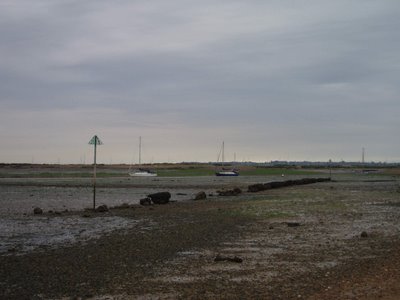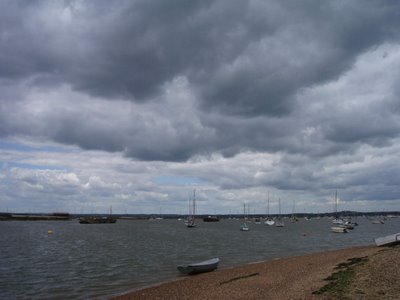Monthly Archives: June 2006
TBTE20060623
Preaching Peace: On GC 2006
Preaching Peace: On GC 2006: “There is a fundamental, structural difference between the sacrifice of Jesus and the sacrifice described at General Convention.”
One of the best analyses of GC2006 I’ve read.
Reading Lists
Since studying English Literature at school (up to age 18) I have held on to two recommended reading lists. I was reminded of them the other day, and I thought I would share them with you.
List One, called ‘A Crash Course in English Literature’, listed by J Neil Waddell
General:
The Book of Common Prayer: Orders for Morning and Evening Prayer
King James Bible: Genesis 1-4, Psalms 9, 19, 23, 24, 46, 90, 100, 137; Ecclesiastes 3; Song of Solomon; Isaiah 9.2-7; Gospel of Matthew; St John 1.1-14; 1 Corinthians 13; The Revelation of St John
Early:
Beowulf
The Battle of Maldon
Chaucer: General Prologue to the Canterbury Tales; Knight’s, Franklin’s or Wife of Bath’s Tale
Gawain and the Green Knight
Poetry:
Shakespeare: Sonnets 1, 2, 15, 18, 29, 55, 60, 64, 71, 130
Donne: The Exstasie, A Nocturnal upon St Lucy’s Day
Herbert: The Agonie, Life
Vaughan: The Waterfall
Milton: Lycidas, Paradise Lost books I and II
Dryden: Absalom and Achitophel
Pope: The Rape of the Lock, An Essay on Man
Gray: Elegy in a Country Churchyard
Keats: Ode to a Nightingale, Ode on a Grecian Urn
Wordsworth: Tintern Abbey
Tennyson: Ulysses, The Lady of Shalott, The Palace of Art, In Memoriam
WB Yeats: Wild Swans at Coole, Easter 1916, Sailing to Byzantium, Byzantium
TS Eliot: Four Quartets, The Waste Land
Drama:
Marlowe: Doctor Faustus
Shakespeare: Love’s Labours Lost, Richard II, Hamlet, King Lear, The Tempest
Tourneur: The Revenger’s Tragedy
Webster: The Duchess of Malfi
Congreve: Love for Love
Wycherley: The Country Wife
Sheridan: School for Scandal, The Rivals
Ibsen: Ghosts, The Doll’s House
Wilde: The Importance of Being Earnest
Chekhov: The Cherry Orchard
Beckett: Waiting for Godot
Osborne: Look Back in Anger
Pinter: The Birthday Party, The Caretaker
Stoppard: Rosencrantz and Guildenstern are Dead
Novels:
Defoe: Robinson Crusoe
Swift: Gulliver’s Travels
Fielding: Joseph Andrews
Sterne: Tristram Shandy
Austen: Emma, Pride and Prejudice
Scott: Waverley
Thackeray: Vanity Fair
Dickens: Great Expectations, Bleak House
Eliot: Middlemarch
James: Portrait of a Lady
Hardy: Tess of the D’Urbervilles, Jude the Obscure
Forster: Howard’s End
List Two, called ‘Novels worth reading’, listed by Andrew Copping 1983
Selected classics:
Henry Fielding: Joseph Andrews, Tom Jones
Laurence Sterne: Tristram Shandy
Walter Scott: The Heart of Midlothian
Jane Austen: Emma, Pride and Prejudice
Charlotte Bronte: Jane Eyre
Emily Bronte: Wuthering Heights
George Eliot: Silas Marner, Mill on the Floss, Middlemarch
WM Thackeray: Vanity Fair
Charles Dickens: Great Expectations, Bleak House
Thomas Hardy: Tess of the D’Urbervilles, Jude the Obscure
Joseph Conrad: Heart of Darkness, Nostromo
James Joyce: Portrait of the Artist as a Young Man
DH Lawrence: Women in Love, Sons and Lovers
Virginia Woolf: To the Lighthouse
EM Forster: A Passage to India
Aldous Huxley: Brave New World
George Orwell: 1984
Evelyn Waugh: Scoop, The Loved One
Post-war novels
Kingsley Amis: Lucky Jim
Stanley Barstow: A Kind of Loving
Malcolm Bradbury: The History Man
John Braine: Room at the Top
Joyce Cary: The Horse’s Mouth
Margaret Drabble: The Millstone
Lawrence Durrell: The Alexandrian Quartet, Justine
John Fowles: The French Lieutenant’s Woman, The Collector
Robert Graves: I, Claudius
Graham Greene: The Power and the Glory, The Comedians
William Golding: The Inheritors, The Spire
LP Hartley: The Go-between
Arthur Koestler: Darkness at Noon
Malcolm Lowry: Under the Volcano
Ian McEwan: In Between the Sheets, The Cement Garden
Compton Mackenzie: Whisky Galore
Nancy Mitford: Pursuit of Love
Iris Murdoch: The Bell, The Sandcastle
Edna O’Brien: Girl with Green Eyes
Alan Paton: Cry, The Beloved Country
Tom Sharpe: Wilt
Nevil Shute: On the Beach
CP Snow: The New Men
Muriel Spark: The Prime of Miss Jean Brodie
Davie Storey: This Sporting Life
JRR Tolkien: The Lord of the Rings
Charles Webb: The Graduate
Patrick White: Riders in the Chariot
The American Novel
James Baldwin: Go Tell it on the Mountain
Saul Bellow: Hertzog
Truman Capote: Breakfast at Tiffany’s
Raymond Chandler: The Big Sleep, The Long Goodbye
JP Donleavy: The Ginger Man
Ralph Ellison: Invisible Man
William Faulkner: As I Lay Dying, The Sound and the Fury
F Scott Fitzgerald: The Great Gatsby
Dashiell Hammett: The Thin Man
Nathaniel Hawthorne: The Scarlet Letter
Joseph Heller: Catch 22
Ernest Hemingway: The Old Man and the Sea
Henry James: Portrait of a Lady
Sinclair Lewis: Babbitt
Carson McCullers: The Heart is a Lonely Hunter
Norman Mailer: The Naked and the Dead
Bernard Malamud: The Assistant
Herman Melville: Moby Dick, Billy Budd
JD Salinger: The Catcher in the Rye
Upton Sinclair: The Jungle
John Steinbeck: The Grapes of Wrath, Of Mice and Men
Mark Twain: Connecticut Yankee in King Arthur’s Court
Nathaniel West: The Cool Million
I’ve read perhaps 20% of these! A lifetime’s task.
TBTM20060623
The mythology of science
“Science, like painting… has a higher aesthetic. Science can be poetry. Science can be spiritual, even religious in a non-supernatural sense of the word.” (Richard Dawkins).
I believe that science is built upon a particular mythology. What I mean is that science as a culturally flourishing phenomenon is propagated by the telling of particular stories; that those stories embody particular values and goals; and those values and goals are ones that are inherently religious, they are values and goals that were previously articulated by religion in general, and Christianity in particular. Thus, the key clash between Christianity and science is not that between a lower and a higher order of intellectual evolution, but between rival mythologies.
One of my principal sources for this belief is a book by the philosopher Mary Midgley, “Science as Salvation: a modern myth and its meaning” (Routledge, 1992), which is excellent and warmly recommended. She writes (p13) “We understand today that it is a bad idea to exterminate the natural fauna of the human gut. But trying to exterminate the natural fauna and flora of the human imagination is perhaps no more sensible. We have a choice of what myths, what visions we will use to help us understand the physical world. We do not have a choice of understanding it without using any myths or visions at all. Again, we have a real choice between becoming aware of these myths and ignoring them. If we ignore them, we travel blindly inside myths and visions which are largely provided by other people. This makes it much harder to know where we are going.”
So what I would like to do here is try and articulate what I see as the ‘foundation myth’ (or meta-narrative) of science. I see this foundation as something which provides both the motivation force for particular scientists (especially the cultural apologists like Dawkins) and also as responsible for the more general acceptance of science within Modern culture.
Once upon a time our ancestors lived in the darkness of ignorance and superstition. Their lives were afflicted by all sorts of horrors – disease was rampant, borne on the backs of dirt and dust, and life was nasty, brutish and short. The Church oppressed free thinking, and forced people – at the point of torture – to accept the rulings of priests and popes, whose authority was arbitrary and archaic, and whose superstitions led to countless wars. Slowly, a few brave men resisted this oppression; they thought for themselves, they demanded evidence and clear reasons. The Church acted against them – they oppressed them with censure, they silenced them and imprisoned them, in some cases they even burned them alive. Yet the truth could not be hidden for ever. After a long period of particularly bloody warfare, when Protestants and Catholics slaughtered each other for decades, leaving nearly a third of the population of Germany dead behind them, our ancestors set up a new way of life. This new way of life was born in England at the end of the seventeenth century, in a Glorious Revolution. The authority of religious figures was reduced, and free thought was encouraged. Two men in particular allowed a new world to come into being. John Locke showed how we could be governed by Reason, both in the political realm without, and our own moral life within. No opinion should be held that could not be demonstrated without sufficient Reason, and in all things Reason should be our guide. Isaac Newton solved the major problems of astronomy and physics, and demonstrated how the world operated according to clear mathematical rules. This Glorious Revolution allowed humanity to progress out from under the cruel yoke of religious tyranny and bigotry. Since that time, we have become Enlightened and, although not all our problems have been solved, we have made tremendous Progress. The methods of Reason, of Empirical Investigation and Science, have been demonstrated to have tremendous power, and we can have confidence that all the difficulties that we face can be met by their continued diligent application. We have made tremendous strides in medicine, so that diseases and pestilence are kept in check. We have improved the fertility of the land so that now there is plenty to eat. We have voyaged from the face of the earth and stood upon the moon, looking down upon the planet of our birth. We have made such Progress, but the struggle with the old ways continues. Around the globe we still see the effect of the old superstitious ways of thinking. In Northern Ireland, in Kashmir, in the Middle East, we still see people who are dominated by religious understandings. It is only through Enlightenment that there is hope for peace. For it is not only in the practical and physical realms that the methods of Science can aid us. As Science progresses, we need to rely less and less upon the traditions of the past, for we can rely upon a sure foundation for knowledge, and have confidence in its prodigality for our future. Most importantly, now that we have Science, we no longer have to resort to superstition when faced with the deep problems: Is there a meaning to life? What are we for? What is man? Science can provide us with the answers, and only Science can offer us the prospect of a better life.
What I would want to emphasise in this story is the ‘drama of salvation’, ie that ‘once we were in darkness, but now we have seen a great light’, and that ‘the light shines in the world and the darkness does not overcome it’. In other words, although the setting of the story is different, the power of the story is deeply dependent upon a religious (Christian) sensibility, ie we needed to be saved, and it is Science that has saved us, and it is by holding fast to Science that we can retain salvation. The distinctive difference between this narrative and the prior Christian narrative is primarily in the virtues that allow for participation in salvation. Instead of corporate (social) values like loyalty, obedience, self-sacrifice etc, now the virtues that are emphasised are independence, autonomy and moral courage.
My point is not to say that there is no truth in this scientific mythology (somewhat the contrary), only to point out that it exists, and that it needs to be evaluated and assessed. I think that it is largely unconscious (the extent to which it is unconscious can be gauged by how far you think the story is “the truth”), and, for better or worse, I think it needs to be brought out into the open.
“People nowadays think that scientists exist to instruct them, poets, musicians, etc. to give them pleasure. The idea that these have something to teach them – that does not occur to them.” (Wittgenstein, 1939)
TBTE20060622
MoQ ecology
This is a brief MoQ post – see here for background context. If you’re not interested in obscure metaphysical discussion, look away now… (My post on a Eudaimonic interpretation of the MoQ may then be of interest – that’s here)
The MoQ sees the biological level as being carried forward by the replication of DNA. That DNA underlies all the variety of biological flora and fauna, from the virus to the plant to the dolphin. Despite the tremendous differentiation between those expressions (phenotypes) of the DNA, they are still in MoQ terms on the same level of evolution – still structured around the replication of DNA. Moreover, the interactions within the level, and between the level and the lower level (physics and chemistry) can be seen as an ecology, ie that it is fluid; without fixed barriers; the whole is more than the sum of the parts.
It seems to me that the same applies to the social level, and that the equivalent of the DNA at the social level is language. Language stretching from the cries of primates in the jungle, to warn of predators, through the mythological structuring of societies by narrative, and (most crucially) including the abstract intellectual exploration of principles and concepts. Much discussion of the MoQ, it seems to me, is vitiated by an overemphasis upon the distinction between, on the one hand, the primitive and narrative-bound language used socially, and the language used in academia and intellectual circles, which seems so different. Yet to my mind this is a category mistake. It is the equivalent of saying that, because a virus and a dolphin are so distinct, the dolphin is at a different level of evolution. Yet both the virus and the dolphin are fundamentally structured through DNA. In the same way, the founding myths of a community (including the scientific community), and all the ways in which those stories are developed (including scientific theories), remain linguistic in how they are structured and reproduced. Language is social; language IS the social level. Language is to the third level (social) what DNA is to the second level (biological).
(Underlying this is an acceptance of Wittgenstein’s view of language. See my post ‘Wittgenstein and the Philosophy of Love’ for an introduction, if you are unfamiliar).
TBTM20060622
Professors of Paranoia?
The Chronicle: 6/23/2006: Professors of Paranoia?
Useful (critical) article on 9/11 conspiracy stuff. (HT Arts and Letters Daily)








